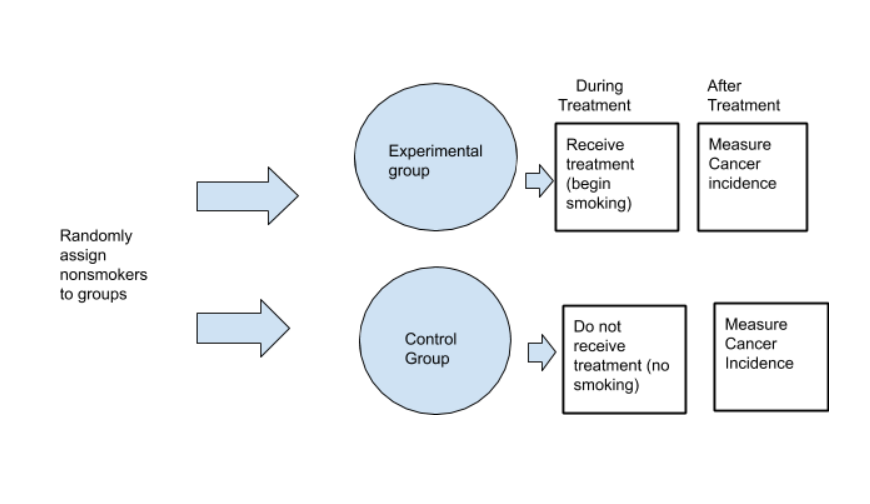In a between-subjects design, the subjects in each group are different; that is, different people serve in the control and experimental groups. The idea behind experimentation, is that the researcher manipulates at least one variable (the independent variable) and measures at least two groups or conditions. In other words, one of the most basic ideas behind an experiment is that there are at least two groups to compare. We typically refer to these two groups or conditions as the control group and the experimental group. The control group is the group that serves as the baseline or “standard” condition. The experimental group is the group that receives some level of independent level. Although we describe the two groups, an experiment may involve the use of two experimental groups with no control group. In other words, there can be multiple experimental groups in experiments.
Experimentation involves control. First, we must control who is in the study. We want to have a sample that is representative of the population about whom we are about to generalize. Ideally, we accomplish these pates in each condition in each condition, so we should use random assignment of subjects in two conditions. By randomly assigning participants to conditions, we are trying to make two groups as equivalent as possible. In addition to controlling all of this, we observe behavioural changes when the independent variable is manipulated, we can then conclude that the independent variable caused these changes in dependent variable.
Let’s consider the example of smoking and cancer to examine the difference between correlational research and experimental research. Remember, we said that there are positive correlational between smoking and cancer. We also noted that no experimental with human supported a causal relationship between smoking and cancer. Why is this case? Let’s think about trying to design an experiment determine whether smoking causes cancer in Humans. Keep in mind potential ethical problems that might arise as we design this experiment.
Let’s first determine the independent variable. If you identified smoking behaviour as the independent variable, you are correct. The control group would be a group that does not smoke, and the experimental group would be the group that does smoke. To prevent confounding of our study by previous smoking behaviour, we could only see non-smokers. We would then randomly assig them into either of the smoking or non-smoking group. In addition to assigning a subject to one of the two conditions, we would control all other aspects of their lives. This means that all participants in the study must be treated exactly the duration of the study, expect the half of them would smoke on a regular basis (we would decide when and how much) and half of them would not smoke at all. We would then determine the length of time for many years for us to access any potential differences between groups. During this time, all aspects of their lives that might contribute to cancer would have to be controlled-held constant between the groups.

FIGURE 9.1 Experimental study of the effects of smoking on cancer rates
What would the dependent variable be? The dependent variable would be the incidence of cancer. After several years had passed, we would begin to take measures on the two groups to determine whether there were any differences in cancer rates. Thus, the cancer rate would be the dependent variable. If the control was maximized, and the experimental group and control group were treated exactly the same expect for the level of independent variable that they received, in any difference observe between the groups in cancer rate would have to be due to the only difference that existed between the groups- the independent variable of smoking. This experimental study is illustrated in Figure 9.1.
You should begin to appreciate the problems associated designing a true experiment to test the effects of smoking and cancer. First, it is not ethical to determine for people whether they smoke. Second, it is not feasible to control all aspects of these individual, lives of the period that is needed to conduct this study indicating that smoke causes cancer in humans.
It is perfectly feasible, however, to conduct experimental studies on other topics. For example, if we want to study the effect of a certain type of mnemonic device (a study strategy) on memory, we could have one group use the device while studying. We could then give each person a memory test and look for a difference between performance in two groups. Assuming would have to be due to the independent variable. If the mnemonic group performed better, we could conclude the mnemonic device caused memory to improve.
The memory study is also known as simple post-test-only control group design. We start with a control group and experimental group made up of equivalent subjects; we administrator the treatment (mnemonic or no mnemonic); and we take a post-test (after treatment) measure. It is very important that the experimental groups and control groups are equivalent because we want to be able to conclude that any differences observe differences observed between the two groups are due to the independent variable and not to some other difference between groups. We help to ensure equivalence of groups by using random assignment.
